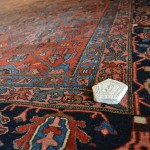My Clay Karbala Stone
Sunnis believe that when the Prophet died, he did not name anyone to succeed him – instead leaving the community to rule themselves through consensus. However Shi’ah Muslims, disagree with this belief, saying that Muhammad appointed Ali and his descendants as his successors and using the Quranic passage: “He whose master I am, Ali is his master” as verification for this. Ali’s descendants are revered as Imams and are the spiritual and political leaders of Shi’ah society.
Because of the importance of the Prophet, the battle of Karbala has significant meaning for Shi’ah Muslims around the world. At Karbala Hussein Ali, a direct descendant of Muhammad, fought against Yazid, who had wrongfully taken the Caliphate. Hussein died as a martyred and his family was killed too. For Shi’ah Muslims around the world, the battle has come to be a symbol of good against evil, of doing what is right even when facing enormous odds.
For my creative project I decided to make a Karbala Prayer Stone. Many Shi’ah Muslims have these stones, made from the clay found near the city of Karbala. It is a small, decorated clay stone that they touch their heads to them when they perform their daily prayers. The idea of thousands of Muslims across the world connecting through the clay of Karbala is very touching, and shows the power of sacrifice. I took photographs of my Karbala stone in different environments, to show how Muslims from all cultures, countries and walks of life connect through the powerful symbol of the Battle of Karbala despite the vast geographic distances between them.











